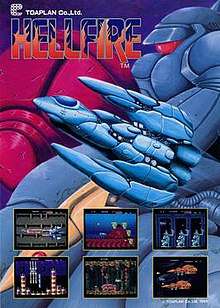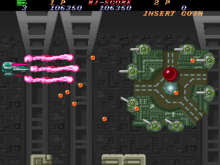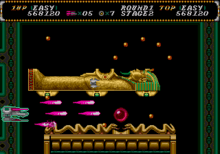Hellfire (video game)
Hellfire[lower-alpha 1] is a 1989 horizontally scrolling shooter arcade video game originally developed by Toaplan and published in Japan by Taito and North America by U.S.A. Games.[1] The first horizontal shoot 'em up title to be created by Toaplan, the game takes place in the year 2998 where a space matter known as Black Nebula created by robot dictator Super Mech spreads and threatens to engulf human-controlled galaxies, as players assume the role of Space Federation member Captain Lancer taking control of the CNCS1 space fighter craft in a surprise attack to overthrow the enemies with the fighter craft's titular weapon.
| Hellfire | |
|---|---|
 Japanese Arcade flyer | |
| Developer(s) | Toaplan NCS Corporation (Genesis) NEC Avenue (PCE Super CD-ROM²) |
| Publisher(s) | Arcade Genesis PCE Super CD-ROM²
|
| Designer(s) | Yuko Tataka |
| Artist(s) | Kōetsu Iwabuchi |
| Composer(s) | Tatsuya Uemura |
| Platform(s) | Arcade, PC Engine Super CD-ROM², Sega Genesis |
| Release | Arcade Genesis PCE Super CD-ROM²
|
| Genre(s) | Horizontally scrolling shooter |
| Mode(s) | |
| Cabinet | Upright |
Conceived by Tatsuya Uemura during his time working at Toaplan and developed in conjunction with Truxton, Hellfire served as an experiment to translate the company's shoot 'em up gameplay style in a horizontal format but faced a problematic development cycle and went through various changes before its eventual launch to the market. Initially launched for the arcades, the game was then ported to the Sega Genesis by NCS Corporation and published worldwide by Masaya, Seismic, Tectoy and Sega between 1990 and 1992, while a PC Engine Super CD-ROM² conversion by NEC Avenue was also published exclusively in Japan on 12 April 1991. Each version of the title features various additions and changes compared with the original release.
Hellfire was met with positive reception from video game magazines since its release in arcades, though some critics drew comparison with Irem's R-Type due to its gameplay style. The Genesis port was also met with positive response from reviewers, while the PC Engine Super CD-ROM² was received with similar response. Its engine would later be repurposed into Zero Wing. As of 2019, the rights to the title is owned by Tatsujin, a company founded in 2017 by former Toaplan member Masahiro Yuge and now-affiliate of Japanese arcade manufacturer exA-Arcadia alongside many other Toaplan IPs.
Gameplay

Hellfire is a science fiction-themed horizontally scrolling shoot 'em up game, where players assume the role of Captain Lancer taking control of the CNCS1 space fighter craft through six increasingly difficult levels, each with a boss at the end that must be fought before progressing any further, in a surprise attack effort to overthrow Super Mech, his army and the Black Nebula space matter as the main objective.[2][3][4][5][6] As far as horizontal scrolling shooters go, the title initially appears to be very standard, as players control their craft over a constantly scrolling background and the scenery never stops moving until the stage boss is reached.[4][6]
A unique gameplay feature is the weapon system;[2][3][4][5][6] unlike other games in the genre released at the time, players are equipped with four main weapons at the beginning that can be upgraded by picking up "P" icons and switch between them by pressing the change button, with each one shooting at a fixed direction no matter which way players move. Other items can also be picked up along the way such as speed increasers and "B" icons that grants a number of points, which are crucial for reaching high-scores to obtain extra lives.[2][4][5][6] The Genesis version introduces the titular main weapon as an extra item capable of obliterating any enemy caught within its blast radius, as the arcade original lacked a bomb mechanic for defense, as well as a shield and a satellite "option".[4][6][7]
Depending on the settings in the arcade version, the title uses either a checkpoint system in which a downed single player will start off at the beginning of the checkpoint they managed to reach before dying, or a respawn system where their ship immediately starts at the location they died at.[6] Getting hit by enemy fire or colliding against solid stage obstacles will result in losing a live, as well as a penalty of decreasing the ship's firepower and speed to his original state and once all lives are lost, the game is over unless the players insert more credits into the arcade machine to continue playing. Although there is an ending, the game loops back to the first stage after completing the last stage as with previous titles from Toaplan, with each one increasing the difficulty and enemies fire denser bullet patterns.
Synopsis
The plot summary of Hellfire varies between each version.[2][4][6] The story takes place in 2998, where humankind has reached a great point in intergalactic travel and space colonization with the help of a peaceful society, however a mysterious space matter known as Black Nebula appeared and begins engulfing different stars before reaching latest colonized galaxy by humans. It is eventually revealed that the force behind this matter is Super Mech, a mysterious robot dictator from the farthest regions of space with the only intention to destroy any resistance that it and its massive space armada faces. A Space Federation member, Captain Lancer, decides to initiate a surprise attack against Super Mech by piloting the only available space fighter craft, the CNCS1, loaded with Hellfire, the strongest weapon available in the galaxy. In the arcade and Genesis versions, Lancer returns safely to Earth after having defeated the Black Nebula, while the PC Engine Super CD-ROM² version features a more poignant ending where the character Kaoru takes her own life in a heroic act of self-sacrifice in order to save the Earth.
Development

Hellfire's creation was helmed by Tatsuya Uemura, former video game composer whose previous development works at Toaplan included Tiger-Heli, Flying Shark and Twin Cobra, becoming his first original project under the role of both producer and composer.[8][9][10][11] Serving as their first horizontal shoot 'em up game, the project was developed in conjunction with Truxton as an experiment to translate Toaplan's vertical shoot 'em up gameplay in a Gradius-style format, however the team faced several issues during the development cycle due to lack of experience, among other factors.[9][10][11][12]
Uemura and members of the team struggled with various aspects of designing a horizontal shoot 'em up title that proved to be frustrating for them like the terrain and collision detection, as their previous experience with vertical shoot 'em up did not carried over a horizontal format.[9][10][11][12] Artist Kōetsu Iwabuchi, who previously worked on Twin Cobra, was responsible for the artwork, stating in a 1990 interview with Gamest that he had no limitation when creating the designs.[13] Uemura also requested for the project to have a puzzle element to be integrated.[9][11] Both the single-player and co-op versions were also created from the beginning of development due to pressure to make two-player games at the time.[12] Despite the difficulties and changes during the creation process, the team managed to finish the project.[12]
The Sega Genesis version of Hellfire was developed by most of the same staff from the original arcade release.[9][14] In a 1990 interview with Japanese game magazine Beep! MegaDrive, designer Yuko Tataka stated that working with the Genesis proved to be equally difficult due to restrictions imposed by the hardware.[14] The PC Engine Super CD-ROM² conversion was solely developed by NEC Avenue.[9][11]
Release

Hellfire was released in arcades across Japan and North America on October 1985 by Taito and U.S.A. Games, becoming one of first releases from Toaplan to prominently feature their name to the public.[1][12] On 25 June 1989, an album containing music from the title and other Toaplan games was published exclusively in Japan by Datam Polystar.[15][16]
On 28 September 1990, Hellfire was ported to the Sega Genesis by NCS Corporation and first released in Japan by Masaya.[17] It was then released in North America by Seismic on November of the same year, while Tectoy and Sega also distributed the title across Brazil and Europe respectively.[18] Both the original arcade version and the later Genesis port are similar but have a number of key differences between each other such as the latter having a smaller color palette and lower screen resolution that led to sprites being recolored and the graphics redrawn in different ways, an arranged soundtrack, new items, among other changes.[6]
On 12 April 1991, a version developed by NEC Avenue for the PC Engine Super CD-ROM² was released under the name Hellfire S,[lower-alpha 2] containing notable differences from the other versions, including a remixed, more orchestral soundtrack, animated cutscenes and the replacement of the leading male character Lancer with a female character called Kaoru (voiced by seiyū Yumi Tōma).[6][19][20]
Reception
| Reception | ||||
|---|---|---|---|---|
| Aggregate scores | ||||
| Aggregator | Scores | |||
| Arcade | Genesis | PCE Super CD-ROM² | ||
| GameRankings | N/A | 59.17%[21] | N/A | |
| Review scores | ||||
| Publication | Scores | |||
| Arcade | Genesis | PCE Super CD-ROM² | ||
| ACE | 600 / 1000[23] | N/A | ||
| Aktueller Software Markt | N/A | 8 / 12[24] | N/A | |
| AllGame | N/A | |||
| Commodore User | 78%[26] | N/A | N/A | |
| Computer and Video Games | N/A | 94%[27] 94 / 100[28] |
N/A | |
| CVG Mean Machines | N/A | 93%[29] | N/A | |
| Electronic Gaming Monthly | N/A | 31 / 40[30] | N/A | |
| Famitsu | N/A | 29 / 40[31] | 24 / 40[32] | |
| GamePro | N/A | 21 / 25[33] | N/A | |
| Gamers | N/A | 3[34] | N/A | |
| Génération 4 | 7 / 10[35] | N/A | N/A | |
| Hobby Consolas | N/A | 94 / 100[36] | N/A | |
| Joypad | N/A | 95%[37] | N/A | |
| Joystick | N/A | 97%[38] | 72%[39] 72%[40] | |
| Mean Machines | N/A | 93%[41] | N/A | |
| Mega Drive Advanced Gaming | N/A | 72%[42] | N/A | |
| Mega Drive Fan | N/A | 18.26 / 30[43] | N/A | |
| Mega Force | N/A | 90%[44] | N/A | |
| MegaTech | N/A | 90%[45] 89%[46] 93%[47] |
N/A | |
| Micromanía | N/A | 44 / 60[48] | N/A | |
| Play Time | N/A | 72%[49] | N/A | |
| Player One | N/A | 84%[50] | N/A | |
| Power Play | N/A | 84%[51] | N/A | |
| Raze | N/A | 82%[52] | N/A | |
| Score | N/A | 60%[53] | N/A | |
| Sega Force | N/A | 92%[54] | N/A | |
| Sega Power | N/A | N/A | ||
| Sega Pro | N/A | 94 / 100[56] | N/A | |
| Tilt | N/A | 14 / 20[57] | N/A | |
| Your Sinclair | 78° / 100°[58] | N/A | N/A | |
| Video Games | N/A | 82%[59] | N/A | |
| Awards | ||||
| Publication(s) | Award(s) | |||
| Video Games (1991) | #7 Besten Mega-Drive-Spiele[59] | |||
| MegaTech (1992) | Hyper Game | |||
| Mega (1992) | #4 Top Mega Drive Games of All Time[60] | |||
In Japan, Game Machine listed Hellfire on their June 15, 1989 issue as being the fourteenth most-successful table arcade unit of the year, outperforming titles such as Wrestle War and Strider.[61] Den of Geek noted it to be "a rare foray into the world of horizontally-scrolling shooters" for Toaplan.[62] The Genesis version was well received.[63] MegaTech magazine said it was "a slick and very good looking blaster which oozes playability". Mega placed the game at #4 in their Top Mega Drive Games of All Time.[60]
Legacy
After the initial release of Hellfire in arcades, Toaplan would go on to develop their second and last horizontal shoot 'em up project; Zero Wing, which was released during the same year and shared the same game engine.[9][11] In more recent years, the rights to the game and many other IPs from Toaplan are now owned by Tatsujin, a company named after Truxton's Japanese title that was founded in 2017 by former Toaplan employee Masahiro Yuge, who are now affiliated with arcade manufacturer exA-Arcadia.[64][65][66][67][68]
Notes
References
- Akagi, Masumi (13 October 2006). タイトー (Taito); 東亜プラン (Toa Plan); U.S.A. Games; H. アーケードTVゲームリスト 国内•海外編 (1971-2005) (in Japanese) (1st ed.). Amusement News Agency. pp. 43, 50, 139, 154. ISBN 978-4990251215.
- Hellfire arcade flyer (Toaplan, JP)
- Hellfire arcade flyer (U.S.A. Games, US)
- Hellfire instruction manual (Sega Genesis, US)
- "HELLFIRE" (in Japanese). Shooting Star. Retrieved 22 November 2019.
- Zverloff, Nick (3 November 2011). "Hellfire". Hardcore Gaming 101. Archived from the original on 17 May 2019. Retrieved 22 November 2019.
- Baize, Anthony (1998). "Hellfire (Arcade) - Review". AllGame. All Media Network. Archived from the original on 16 November 2014. Retrieved 22 November 2019.
- Abeto, Kobatsu (September 1989). "東亜プランインタビュー". PSG (in Japanese). Vol. 10. FSG. (Translation by Shmuplations. Archived 2017-05-31 at the Wayback Machine).
- Iona; VHS; K-HEX (June 2009). "東亜プラン FOREVER (3/5)". Floor 25 (in Japanese). Vol. 9. (Translation by Gamengai. Archived 2019-11-22 at the Wayback Machine).
- "東亜プラン シューティングクロニクル". SweepRecord (in Japanese). SuperSweep. 14 November 2011. Archived from the original on 21 October 2019. Retrieved 15 February 2020. (Translation by Shmuplations. Archived 2018-07-11 at the Wayback Machine).
- Kiyoshi, Tane; hally (VORC); Yūsaku, Yamamoto (3 February 2012). "東亜プラン特集 - 元・東亜プラン 開発者インタビュー: 上村建也". Shooting Gameside (in Japanese). Vol. 4. Micro Magazine. pp. 33–40. ISBN 978-4896373844. (Translation by Shmuplations. Archived 2019-09-06 at the Wayback Machine).
- "東亜プラン シューティングクロニクル 特設ページ". SweepRecord (in Japanese). SuperSweep. 27 October 2011. Archived from the original on 15 February 2020. Retrieved 15 February 2020. (Translation by Shmuplations. Archived 2019-10-02 at the Wayback Machine).
- "東亜プラン". Gamest (in Japanese). No. 49. Shinseisha. September 1990. pp. 68–69. (Translation by Shmuplations. Archived 2019-11-07 at the Wayback Machine).
- "当世ゲーム業界 働く女性事情 - ワーキング・ガール: 田高祐子•二藤早苗 (東亜プラン) Character Designer". Beep! MegaDrive (in Japanese). No. 14. SoftBank Creative. November 1990. p. 87. (Translation by Shmuplations. Archived 2019-11-21 at the Wayback Machine).
- "H24X-10005 | TATSUJIN ~TOA PLAN GAME MUSIC SCENE ONE~". vgmdb.net. VGMdb. Archived from the original on 8 May 2019. Retrieved 23 November 2019.
- Kotowski, Don (1 August 2012). "Truxton -Toaplan Game Music Scene-". vgmonline.net. Video Game Music Online. Retrieved 23 November 2019.
- "MEGA DRIVE Soft > 1990" (in Japanese). GAME Data Room. Archived from the original on 1 October 2018. Retrieved 21 November 2019.
- "Fact-Files - Genesis - Hellfire". Electronic Gaming Monthly. No. 16. Sendai Publishing. November 1990. pp. 74–75.
- "PC-ENGINE Soft > 1991" (in Japanese). GAME Data Room. Archived from the original on 1 October 2018. Retrieved 21 November 2019.
- "Hellfire S". pcengine.co.uk. The PC Engine Software Bible. Retrieved 23 November 2019.
- "Hellfire for Genesis". GameRankings. CBS Interactive. 2019. Archived from the original on 16 May 2019. Retrieved 22 November 2019.
- Smith, Andy (July 1989). "Arcade Ace - Hellfire". ACE. No. 22. EMAP. p. 23. Archived from the original on 26 March 2016. Retrieved 22 November 2019.
- Haynes, Rik (January 1991). "Screentest - Console - Hellfire: Is this NCS/TOAPLAN Megadrive shoot a scorcher?". ACE. No. 40. EMAP. p. 101. Archived from the original on 1 April 2016. Retrieved 22 November 2019.
- Blum, Torsten (December 1990). "Konsolen - Hammerhart!". Aktueller Software Markt (in German). No. 47. Tronic Verlag. p. 105.
- Baize, Anthony (1998). "Hellfire (Sega Genesis) - Overview". AllGame. All Media Network. Archived from the original on 15 November 2014. Retrieved 22 November 2019.
- "Arcades - Hellfire (Taito/Toaplan)". Commodore User. No. 69. EMAP. June 1989. p. 99.
- Leadbetter, Richard (December 1990). "CVG Review: Hellfire (Megadrive)". Computer and Video Games. No. 109. Future Publishing. pp. 148–149. Archived from the original on 13 June 2016. Retrieved 22 November 2019.
- "CVG Group Test: Mega Drive - Hellfire (Sega)". Computer and Video Games. No. 151. Future Publishing. June 1994. pp. 106–111.
- Rignall, Julian (November 1990). "Complete Guide to Consoles – The Complete Games Guide – Megadrive – Hellfire". Computer and Video Games Mean Machines. No. 4. EMAP. p. 31.
- Harris, Steve; Semrad, Ed; Alessi, Martin; Williams, Ken (March 1991). "Review Crew - Genesis - Hellfire". Electronic Gaming Monthly. No. 20. Sendai Publishing. p. 18.
- "ヘルファイヤー (メガドライブ) - ファミ通.com". Famitsu (in Japanese). No. 111. ASCII. 12 October 1990. Retrieved 22 November 2019.
- "ヘルファイアーS (PCエンジン) - ファミ通.com". Famitsu (in Japanese). ASCII. Retrieved 22 November 2019.
- Mo, Slo (December 1990). "Genesis ProView: Hellfire". GamePro. No. 17. IDG. p. 130.
- "Test Mega Drive: Hellfire". Gamers (in German). No. 2. MLV-Verlag. February 1992. p. 24.
- "Sous Les Arcades - Hellfire (Taito)". Génération 4 (in French). No. 15. Computec Media France. October 1989. p. 59.
- Sanz, José Luis; García, Marcos (April 1992). "Lo Más Nuevo (Megadrive) - ¡Eso es un infierno! - Hellfire". Hobby Consolas (in Spanish). No. 7. Axel Springer SE. pp. 56–59.
- Huyghues-Lacour, Alain; Morisse, Jean-François (April 1992). "French Collection: Hellfire - Des Aliens, Encore Des Aliens, Toujours Des Aliens!". Joypad (in French). No. 7. Yellow Media. pp. 140–141. Archived from the original on 17 September 2017. Retrieved 22 November 2019.
- Demoly, Jean-Marc (November 1990). "Tests - Megadrive - Hellfire". Joystick (in French). No. 10. Anuman Interactive. p. 134.
- Demoly, Jean-Marc (May 1991). "Tests - PC Engine CD ROM - Hellfire S". Joystick (in French). No. 16. Anuman Interactive. p. 172.
- "Console News - NEC CD-Rom: Hellfire". Joystick (in French). No. Hors-Serie 3. Anuman Interactive. July–August 1991. p. 97.
- Matt; Julian (December 1990). "Megadrive Review – Hellfire". Mean Machines. No. 3. EMAP. pp. 74–76.
- "Review: Hellfire". Mega Drive Advanced Gaming. No. 5. Maverick Magazines. January 1993. p. 92.
- "Mega Drive & Game Gear All Catalog '93 7月号特別付録 - ヘルファイヤー". Mega Drive Fan (in Japanese). No. 42. Tokuma Shoten. 15 July 1993. p. 65.
- "Zapping - Megadrive - Hellfire". Mega Force (in French). No. 5. MegaPress, S.A.R.L. March–April 1992. p. 105.
- "Game Index - Hellfire". MegaTech. No. 1. EMAP. December 1991. p. 78.
- "Review: Sol-Feace - Alternatively... -- Hellfire". MegaTech. No. 2. EMAP. February 1992. p. 23.
- "Hellfire". MegaTech. No. 5. EMAP. May 1992. p. 78.
- J.E.B. (May 1992). "Video Consolas - Lo Mejor De Lo Mejor - Hellfire (Megadrive)". Micromanía (in Spanish). Vol. 2 no. 48. HobbyPress. p. 67.
- Menne, Oliver; Gnad, Stefan (May 1992). "Mega Drive Review - Hellfire". Play Time (in German). No. 12. CT Computec Verlag GmbH & Co. KG. p. 93.
- Scamps, Olivier (April 1992). "Tests De Jeux - Mega D. - Hellfire". Player One (in French). No. 19. Média Système Édition. pp. 62–63. Archived from the original on 18 October 2017. Retrieved 22 November 2019.
- Gaksch, Martin (December 1990). "Power Tests - Video-Spiele: Fahr Zur Hölle - Hellfire". Power Play (in German). No. 33. Future Verlag. p. 154.
- "Import - Hellfire". Raze. No. 3. Newsfield. January 1991. p. 71. Archived from the original on 23 March 2019. Retrieved 22 November 2019.
- Eisler, Jan (March 1994). "SEGA - Hellfire". Score (in Czech). No. 3. Omega Publishing Group. p. 47. Archived from the original on 11 April 2016. Retrieved 22 November 2019.
- Mellerick, Paul (May 1992). "Sega Force Mega Blaster - Reviewed! -- Mega Drive: Hellfire". Sega Force. No. 5. Europress Impact. pp. 56–57.
- Jarratt, Steve (October 1991). "The Hard Line – Hellfire (Import)". Sega Power. No. 23. Future plc. p. 53.
- "ProReview: Guide To Shoot-'Em Ups - Hellfire". Sega Pro. No. 9. Paragon Publishing. July 1992. pp. 28–29.
- Huyghues-Lacour, Alain (December 1990). "Rolling Softs - Hellfire -- Megadrive, cartouche Sega". Tilt (in French). No. 84. Editions Mondiales S.A. pp. 114–116. Archived from the original on 13 August 2016. Retrieved 22 November 2019.
- Bielby, Matt (August 1989). "Slots Of Fun - Hellfire". Your Sinclair. No. 44. Dennis Publishing. pp. 74–75. Archived from the original on 10 October 2016. Retrieved 22 November 2019.
- "Die Besten Spiele - Die Besten Mega-Drive-Spiele". Video Games (in German). No. 1. Future-Verlag. January 1991. p. 25.
- "Top 100 - 4. Hellfire". Mega. No. 1. Future Publishing. October 1992. p. 77.
- "Game Machine's Best Hit Games 25 - テーブル型TVゲーム機 (Table Videos)". Game Machine (in Japanese). No. 358. Amusement Press, Inc. 15 June 1989. p. 21.
- Lambie, Ryan (21 June 2018). "Toaplan: the rise and fall of Japan's greatest shooting game company". Den of Geek. Dennis Publishing. Archived from the original on 21 June 2018. Retrieved 23 November 2019.
- "Console News - Megadrive: Hellfire". Joystick (in French). No. Hors-Serie 3. Anuman Interactive. July–August 1991. p. 106.
- "ライセンス事業" (in Japanese). TATSUJIN Co., Ltd. 2019. Archived from the original on 25 December 2018. Retrieved 21 November 2019.
- Bravo, Roberto (12 September 2018). "Nueva compañía "Tatsujin" asegura tener gran parte de las IPs de la extinta Toaplan" (in Spanish). Gamercafe. Archived from the original on 21 October 2019. Retrieved 21 November 2019.
- "Tatsujin". exA-Arcadia. 2019. Archived from the original on 21 October 2019. Retrieved 21 November 2019.
- Bravo, Roberto (25 January 2019). "Tatsujin, los dueños de Toaplan, anuncian que están trabajando para exA-Arcadia" (in Spanish). Gamercafe. Archived from the original on 21 October 2019. Retrieved 21 November 2019.
- "[JAEPO2019]TATSUJINやナツメアタリの参入が発表されたexA-Arcadia。出展コーナーの模様を紹介". 4Gamer.net (in Japanese). Aetas Inc. 26 January 2019. Archived from the original on 21 October 2019. Retrieved 21 November 2019.
External links
- Hellfire at GameFAQs
- Hellfire at Giant Bomb
- Hellfire at Killer List of Videogames
- Hellfire at MobyGames
- Hellfire at The Toaplan Museum
- Hellfire S at MobyGames

